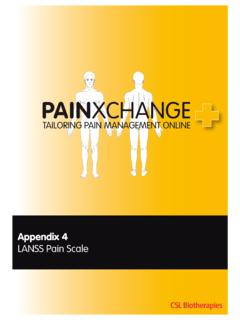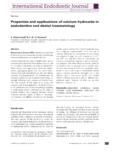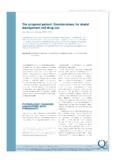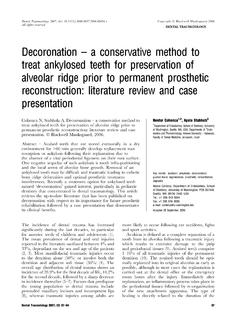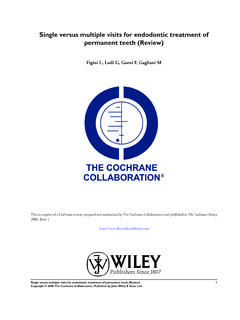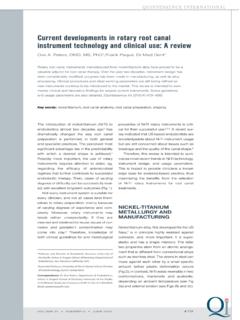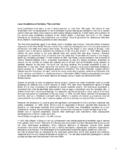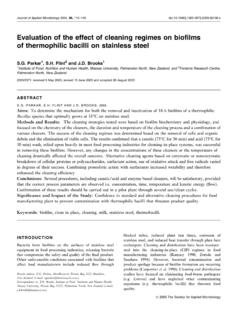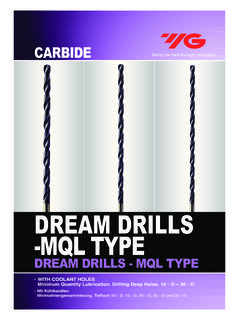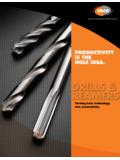Transcription of The Segmental Ridge-Split Procedure - EndoExperience
1 J Periodontol May 2003 Innovations in Periodontics757 This report details surgical procedures for ridge expan-sion by means of splitting the crest of an edentulousridge. Atrophic bony ridges present a unique chal-lenge to the dental implant surgeon. In the past, onlaygrafts of bone harvested from the hip, maxillarytuberosity, symphysis of the chin, or external obliqueridge have all been used with success in reconstruc-tion of atrophic ridges. However, bone onlay graftingprocedures require a secondary surgical site, whichexhibits typical postoperative morbidity associatedwith bone harvesting performed with chisels andburs. Additionally, onlay grafts often require a heal-ing period of 6 months to a year before dental implantscan be placed, and the onlay graft sometimes fails tofuse to the augmented site. The Segmental ridge -splitprocedure provides a quicker method wherein anatrophic ridge can be predictably expanded andgrafted with bone allograft, eliminating the need fora second surgical site.
2 J Periodontol 2003;74 WORDSA lveolar ridge augmentation/methods; dentalimplants; esthetics, dental; grafts, bone/methods; ridge expansion; Ridge-Split Procedure ; Segmental Ridge-Split Procedure presented hereis a modification of the procedures originally devel-oped by Simion et Scipioni et laterdiscussed by Nevins and have added somealterations to those original techniques, which wehave found to be supplemental to preserving boneplates while enhancing reconstruction of lost this light, we wish to present the Segmental Ridge-Split Procedure (SRSP), a Procedure that we believeaffirms the efficacy of the split -crest1and the bone allografts have been known inperiodontal surgery for over a quarter of a century,4and the usefulness of freeze-dried bone allografts(FDBA) has been reported repeatedly in periodontalbone grafting was not until the late1950s that it was understood that demineralized graftsare replaced faster than non-demineralized graftswhen used in surgical con-centrations in mineralized grafts fall prior to rising,which suggested that these grafts had to undergodemineralization in situbefore being converted tomature distinction between FDBA anddemineralized freeze-dried bone (DFDBA)
3 Was bothrecognized and studied in the treatment of periodon-tal ,8 DFDBA has been used with varyinglevels of success in periodontal bone grafting , a number of well-designed stud-ies also failed to identify any positive effect from theuse of DFDBA in bone grafting specifically examined the potential of aug-menting atrophic ridges with DFDBA and found thatthe material showed little, if any, of the reported differences in the efficacy ofDFDBA may be related to the reconstitution and prepa-ration of the allograft bone material. When it is possi-ble to obtain autogenous bone, the combination ofDFDBA and autogenous cancellous bone has provento be an especially effective grafting material. This isparticularly true when the combination graft is encasedwithin an area surrounded by bone and importance of periosteum in osteogenesis duringbone grafting techniques has been demonstrated by anumber of re-formation is notgenerally independent of soft tissue management andclosure.
4 When autogenous or allogenic bone graftThe Segmental Ridge-Split ProcedureGary W. Coatoam* and Angelo Mariotti * Private practice, Altamonte Springs, FL. Department of Periodontics, The Ohio State University, Columbus, 5/16/03 8:30 AM Page 757 Volume 74 Number 5 Innovations in Periodonticsmaterials are isolated within an area surrounded bybony walls and periosteum, preosteoblasts and func-tional osteoblasts can readily enter the graft. At leastone-third of early graft osteogenesis can be attributedto the periosteum observations sug-gest that successful bone reconstruction might beinfluenced by graft selection combined with carefullydesigned tissue manipulation and tissue manage-ment. The Segmental Ridge-Split Procedure (SRSP)creates a crypt surrounded by bone and periosteuminto which implants and bone graft materials can beintroduced with reasonable confidence that new bonecan be constructed and that this new bone will pro-vide a solid base for dental ASSESSMENTP atients should be healthy and mentally adjusted tothe rigors of implant procedures .
5 Although youngerpatients generally have better bone quality and seemto have better postoperative healing, there has beenno identified age limitation to Segmental ridge -splitprocedures. Our patients have ranged from 13 yearsto 67 years of and reassessment of the patient areperformed before, during, and after the surgical pro-cedures. Good oral hygiene is crucial to the successof the surgery and the ensuing dental implant pros-thesis. Any inadequacy in this important area is unac-ceptable and may immediately disqualify the patientfor consideration for the Procedure . The patient whosmokes is also a rather poor candidate for our experience, this has been found to be partic-ularly true for Ridge-Split planning is essential to the success ofridge- split procedures . Panoramic, periapical, occlusal,cephalometric, and tomographic radiographs can alladd invaluable information prior to entry into the siteof the atrophic offices are equipped totake at least occlusal and periapical films.
6 In addition,it is recommended that practitioners placing implantsshould have access to panoramic films of their is best to advise the patient that implants maynot be placed at the initial Ridge-Split Procedure owingto the challenge of attaining implant fixation or diffi-culty manipulating the bone plates. procedures con-fined to single-tooth sites can often be treated withsimultaneous Ridge-Split and implant AND METHODSR azor-sharp bone chisels were used when perform-ing Ridge-Split procedures described here. A surgicalmallet is necessary, and should be an instrument thatis comfortable to the surgeon. The split of an atrophicridge can be likened to an art form, and the surgicalmallet should be a balanced instrument, which canbe used to impart gentle but precise blows to thechisels and osteotomes. Often, practitioners will exper-imentwith several different styles of mallets to findthe one that suits their tactile drills or small spiral drills must be avail-able to create holes for the passage of stainless-steelligature wires.
7 The mm dead-soft stainless-steelwire is ligated across the bone plates if there is anylooseness in the plates after the ridge has been space between the plates is generally graftedwith 300 to 500 m DFDBA combined with auto-genous bone when possible; plus, we feel that theDFDBA should always be reconstituted with thepatient s the patient has no known allergies toachromycin, the incisions are coated with a copiousapplication of 3% achromycin ointment#after sutur-ing is complete. The patient is also instructed to usetwice-daily rinses of chlorhexidine mouthrinse.**SURGICAL TECHNIQUES ince periodontal disease and/or endodontic pathol-ogy may lead to destruction of alveolar bone (Fig. 1),even when precautions are taken such as bone graft-ing the extraction sites (Fig. 2), it is not extremely758 The Segmental Ridge-Split Procedure 04-000-47 and 454-4701, Ace Surgical Supply Co., Brockton, MA. Ace Surgical Supply Co.
8 Tru-Chrome ligature wire, Rocky Mountain Orthodontics, Denver, CO. Michigan Tissue Bank, Lansing, MI.# Lederle Labs, Pearl River, NY.** Peridex, Procter & Gamble, Cincinnati, radiographs of 2 hopeless teeth: the maxillary rightcuspid and 5/16/03 8:30 AM Page 758J Periodontol May 2003 Innovations in Periodonticsphotography of the site. However, the site shouldnever be completely dried and blood vessels shouldnever be cauterized. Additionally, it is inadvisable touse high-concentration vasoconstrictive agents dur-ing the surgery or entry incision into the surgical site should beplanned to allow for primary closure of the site. Thiswill be discussed in greater detail, as the require-ments for that closure are considered. However, theentry is generally made palatal to the crest of theridge. Though mid-crestal incisions can be managed,the shift of the incision line toward the palate tendsto facilitate closure.
9 However, excessive palatal rugaeor other anatomical considerations may affect theexact position of this the maxillary anterior region, it is not uncommonto find that the atrophy of the ridge has been at theexpense of the facial bone (Fig. 4). The crest of theridge may be less than 3 mm in bucco-palatal width,and a facial bone concavity is often present superiorto the crest of the ridge . Any attempt to place implantsin this situation would result in a dehiscence at theosteotomy opening, and often result in a fenestrationat the facial concavity. Even when implant placementis possible, the surgeon is often forced to place theimplants with a significant facial flare. Flared implantstend to be more challenging to restore. SRSP canoften resolve many of these first step in the Segmental Ridge-Split procedureis the creation of a 1 to 3 mm deep seam along thelength of the ridge (Fig. 5). The seam should cometo within 2 mm of the adjacent teeth, but no closer(Fig.)
10 6). The entire length of the seam should beCoatoam, Mariotti759 Figure panorex showing healing of the bone-grafted socketsat 12 reentry into post-extraction sites showing the thinatrophic to open an edentulous ridge only to findthin atrophic bone (Fig. 3). Rather than abandoningthe implant Procedure , a Segmental Ridge-Split pro-cedure may be performed. In this Procedure (SRSP),the entire edentulous bony segment is opened likean envelope to receive the implants. During the courseof these procedures , it is important to maintain thevitality of the bone to every degree possible. Irriga-tion of the field should be with saline rather than tapwater, plus it is advisable to keep a manageableamount of blood pooled around the bone plates. Anysaline irrigation should be cold, especially duringdrilling procedures . The surgical site may be dabbedwith gauze or lightly suctioned for visualization orFigure loss of horizontal ridge dimension, particularly in thecuspid 5/16/03 8:30 AM Page 759 Volume 74 Number 5 Innovations in Periodonticsestablished prior to deepening the split .
